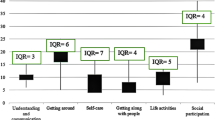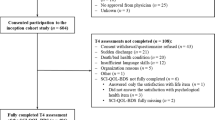Abstract
Study design:
Longitudinal study.
Objectives:
To examine the relationship between and predictors of quality of life (QOL) at 3 and 15 months post-rehabilitation discharge using the Disability Creation Process model as an explanatory framework.
Setting:
Vancouver, Canada.
Methods:
A consecutive sample of individuals with spinal cord injury (SCI) was enrolled in the study. Data were collected using the Quality of Life Index (QLI) and a variety of personal, participation and environmental instruments. On admission, 197 subjects were recruited, but dropouts and missing values led to the final inclusion of 93 cases in multiple regression models used to identify predictors of QOL at 3 and 15 months post-rehabilitation discharge.
Results:
Mean QLI group scores did not differ between 3 and 15 months (P=0.85). Regression models accounted for 64% of variance in QLI total scores at 3 months and 70% of variance at 15 months. The main predictors of QOL at 3 months were health competence and mood state. The main predictors of QOL at 15 months were QOL level at 3 months, health competence and family support. At both time points, personal factors explained most of the variance, whereas participation and environmental factors were less significant.
Conclusion:
Given that health competence, mood state and some environmental factors may be amenable to modification, this study suggests interventions to mediate these variables might improve subjective QOL after SCI.
Similar content being viewed by others
Log in or create a free account to read this content
Gain free access to this article, as well as selected content from this journal and more on nature.com
or
References
Fougeyrollas P, Noreau L, Boschen KA . Interaction of environment with individual characteristics and social participation: theoretical perspectives and applications in persons with spinal cord injury. Top Spinal Cord Inj Rehabil 2002; 7: 1–16.
Dijkers MP . Quality of life of individuals with spinal cord injury: a review of conceptualization, measurement, and research findings. J Rehabil Res Dev 2005; 42: 87–110.
Hammell KW . Exploring quality of life following high spinal cord injury: a review and critique. Spinal Cord 2004; 42: 491–502.
Hampton NZ, Marshall A . Culture, gender, self-efficacy, and life satisfaction: a comparison between Americans and Chinese people with spinal cord injuries. J Rehabil 2000; 66: 21–28.
Whiteneck G, Meade MA, Dijkers M, Tate DG, Bushnik T, Forchheimer MB . Environmental factors and their role in participation and life satisfaction after spinal cord injury. Arch Phys Med Rehabil 2004; 85: 1793–1803.
American Spinal Injury Association [Internet]. Standard Neurological Classification of Spinal Cord Injury (revised 2006, March; cited 2008 Sept 3) [2 screens]. Available from http://www.asia-spinalinjury.org/publications/2006_Classif_worksheet.pdf.
Gibson SJ . The measurement of mood states in older adults. J Gerontol B Psychol Sci Soc Sci 1997; 52: P167–P174.
Kerns RD, Turk DC, Rudy TE . The West Haven-Yale Multidimensional Pain Inventory (WHYMPI). Pain 1985; 23: 345–356.
Stineman MG, Shea JA, Jette A, Tassoni CJ, Ottenbacher KJ, Fiedler R et al. The functional independence measure: tests of scaling assumptions, structure, and reliability across 20 diverse impairment categories. Arch Phys Med Rehabil 1996; 77: 1101–1108.
Ottenbacher KJ, Hsu Y, Granger CV, Fiedler RC . The reliability of the functional independence measure: a quantitative review. Arch Phys Med Rehabil 1996; 77: 1226–1232.
Scholz U, Gutiérrez-Doña B, Sud S, Schwarzer R . Is perceived self-efficacy a universal construct? Psychometric findings from 25 countries. Eur J Psychol Assess 2002; 18: 242–251.
Smith MS, Wallston KA, Smith CA . The development and validation of the Perceived Health Competence Scale. Health Educ Res 1995; 10: 51–64.
Scheier MF, Carver CS . Optimism, coping, and health: assessment and implications of generalized outcome expectancies. Health Psychol 1985; 4: 219–247.
Noreau L, Desrosiers J, Robichaud L, Fougeyrollas P, Rochette A, Viscogliosi C . Measuring social participation: reliability of the LIFE-H in older adults with disabilities. Disabil Rehabil 2004; 26: 346–352.
Desrosiers J, Noreau L, Robichaud L, Fougeyrollas P, Rochette A, Viscogliosi C . Validity of the assessment of life habits in older adults. J Rehabil Med 2004; 36: 177–182.
Boschen K, Noreau L, Fougeyrollas P . A new instrument to measure the quality of environment for persons with physical disabilities. Arch Phys Med Rehabil 1998; 79: 1331.
Procidano ME, Heller K . Measures of perceived social support from friends and from family: three validation studies. Am J Community Psychol 1983; 11: 1–24.
Ferrans CE, Powers MJ . Psychometric assessment of the Quality of Life Index. Res Nurs Health 1992; 15: 29–38.
Ferrans CE, Powers MJ . Quality of life index: development and psychometric properties. ANS Adv Nurs Sci 1985; 8: 15–24.
May La, Warren S . Measuring quality of life of persons with spinal cord injury: External and structural validity. Spinal Cord 2002; 40: 341–350.
Kleinbaum DG, Kupper LL, Muller KE, Nizam A . Applied Regression Analysis and Other Multivariable Methods. Cole Publishing: Pacific Grove, CA, 1998.
Kennedy P, Rogers B . Reported quality of life of people with spinal cord injuries: a longitudinal analysis of the first 6 months post-discharge. Spinal Cord 2000; 38: 498–503.
Sprangers MA, Schwartz CE . Integrating response shift into health-related quality of life research: a theoretical model. Soc Sci Med 1999; 48: 1507–1515.
Acknowledgements
We thank all individuals who participated in this research and the acute and rehabilitation facility members of the Quebec SCI Centers of Expertise that include Hôpital Sacré-Cœur de Montréal, Centre hospitalier affilié de Québec, Institut de réadaptation de Montréal, Institut de réadaptation en déficience physique de Québec and the Centre de réadaptation Lucie-Bruneau. Dr Mortenson's work was supported by a Quality of Life Strategic Training Fellowship in Rehabilitation Research from the Canadian Institutes of Health Research Musculoskeletal and Arthritis Institute, the Canadian Occupational Therapy Foundation and graduate fellowships from the Canadian Institutes of Health Research and Michael Smith Foundation for Health Research. Salary support for Dr Miller was provided by the Canadian Institutes of Health Research, Institute of Aging. This study was sponsored by the Comité directeur de la recherche en neurotraumatologie, Quebec Rehabilitation Institute Foundation, and the center for Interdisciplinary Research in Rehabilitation and Community Integration.
Author information
Authors and Affiliations
Corresponding author
Rights and permissions
About this article
Cite this article
Mortenson, W., Noreau, L. & Miller, W. The relationship between and predictors of quality of life after spinal cord injury at 3 and 15 months after discharge. Spinal Cord 48, 73–79 (2010). https://doi.org/10.1038/sc.2009.92
Received:
Revised:
Accepted:
Published:
Issue date:
DOI: https://doi.org/10.1038/sc.2009.92
Keywords
This article is cited by
-
Life satisfaction in persons with spinal cord injury across the seasons
Spinal Cord (2021)
-
Quality of life in the subacute period following a cervical traumatic spinal cord injury based on the initial severity of the injury: a prospective cohort study
Spinal Cord (2018)
-
Essential gains and health after upper-limb tetraplegia surgery identified by the International classification of functioning, disability and health (ICF)
Spinal Cord (2017)
-
Conceptualization and measurement of disability in studies on subjective well-being: a critical review and evidence from the Italian Health Surveys
International Review of Economics (2017)
-
Latrine access and utilization among people with limited mobility: A cross sectional study
Archives of Public Health (2016)



